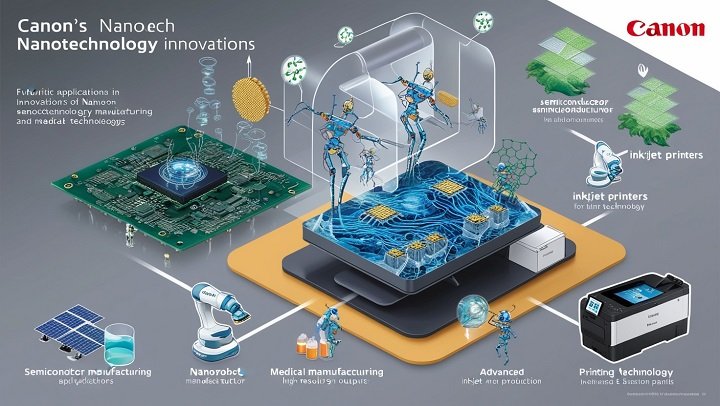Canon Nanotechnologies in today’s rapidly evolving world of technology, the word nanotechnology is becoming increasingly common. But what does it mean, and why is it important? Simply put, nanotechnology refers to the science of working with incredibly small particles—so small, in fact, that you can’t see them with the naked eye. One of the leading companies exploring this area is Canon. Most of us recognize Canon for their cameras and printers, but they’re also making incredible advances in nanotechnologies. In this blog, we’ll dive into the fascinating world of Canon nanotechnologies, explain why they matter, and how these tiny innovations are shaping the future.
What is Nanotechnology? Canon Nanotechnologies

This type of technology is used in various fields, including medicine, electronics, energy, and environmental protection. For instance, some medicines today are designed at the nanoscale to target specific areas of the body more effectively. Likewise, electronics are getting smaller and faster thanks to advances in nanotechnology.
Canon’s Role in Nanotechnology
When we think of Canon, we often associate it with cameras, but their innovations go far beyond photography. Canon is pushing the boundaries of what’s possible with nanotechnology, focusing on its applications in fields like semiconductor manufacturing, medical devices, and printing. By using nanotechnology, Canon can create products that are more efficient, precise, and powerful than ever before.
1. Semiconductor Lithography
One of Canon’s most significant contributions to nanotechnology is in the area of semiconductor lithography. Semiconductors are the tiny chips that power our electronics—everything from smartphones to computers. Semiconductor lithography is the process used to create the intricate patterns on these chips, and nanotechnology plays a key role in this process.
Canon’s advances in nanotechnology allow them to produce these chips with even smaller and more precise features. As a result, electronic devices become more powerful and energy-efficient. Canon’s Nanoimprint Lithography (NIL) technology, for example, is considered a game-changer in the industry, enabling high-resolution patterning for semiconductors with remarkable accuracy.
2. Medical Applications
Another exciting application of Canon’s nanotechnology efforts is in the medical field. Imagine being able to detect diseases early or deliver medication to a specific part of the body with absolute precision. Nanotechnology makes this possible. Canon is working on creating nanoscale medical devices that can improve diagnostics and treatment.
One example is the development of tiny sensors that can detect specific biological markers. These sensors can be used for early disease detection, making treatments more effective. Additionally, Canon is exploring nanorobots, which are small enough to navigate through the human body and deliver drugs to specific cells or tissues, reducing side effects and improving outcomes.
3. Printing Technology
Canon has always been a leader in the printing industry, and their innovations in nanotechnology are pushing the envelope even further. By using nanotechnology in inkjet printing, Canon can achieve higher resolution prints with greater color accuracy. These advances have wide-reaching implications—not only for consumer products like home printers but also for industrial applications such as printing circuit boards for electronics.
This not only results in better-quality prints but also makes the printing process more efficient, reducing the amount of ink wasted. It’s a small change, but it makes a big difference, especially in large-scale industrial printing.
4. Environmental Impact and Sustainability of Canon Nanotechnologies
Nanotechnology also plays a key role in Canon’s commitment to environmental sustainability. By making devices more efficient, Canon is helping to reduce energy consumption and waste. For example, nanostructured materials are being used in their products to improve energy efficiency and reduce the environmental impact of manufacturing processes.
Moreover, Canon’s research in nanomaterials is helping to develop new types of solar panels that are more efficient and affordable. By using these advanced materials, Canon aims to make renewable energy more accessible to everyone, which is crucial in the fight against climate change.
5. Future of Canon Nanotechnologies
From improving data storage in electronics to creating smart fabrics that can monitor health, the possibilities are endless. Canon’s investment in research and development ensures that they remain at the forefront of this technology, driving innovation across multiple industries.
We can expect to see even more exciting developments in the coming years, as Canon continues to explore the full potential of nanotechnology. Whether it’s in medicine, electronics, or environmental sustainability, these tiny innovations will have a big impact on our world.
How Does Nanotechnology Benefit Us?

- Smarter Electronics: With nanotechnology, electronic devices are becoming faster, smaller, and more powerful. This means better smartphones, faster computers, and even smarter appliances.
- Improved Healthcare: Nanotechnology is already making waves in healthcare, allowing for earlier disease detection and more targeted treatments. This means we can catch illnesses before they become severe and treat them more effectively.
- Energy Efficiency: As we’ve seen, nanotechnology is helping create more efficient solar panels and energy-saving devices. This is essential in our effort to combat climate change and reduce our reliance on fossil fuels.
- Eco-Friendly Products: Many products, from paints to packaging, are being enhanced with nanomaterials that make them more durable and environmentally friendly.
Conclusion
Nanotechnology may be small, but its impact is enormous. Canon’s work in this field demonstrates just how powerful this technology can be. Whether it’s making electronics more efficient, improving medical treatments, or helping the environment, nanotechnology is shaping the future in ways we’re only beginning to understand.
As we look forward, the advances made by Canon in nanotechnology will continue to push the boundaries of what’s possible, leading to smarter devices, better healthcare, and a more sustainable planet.
For further reading on nanotechnology and its impact on various industries, you can visit this insightful article.




